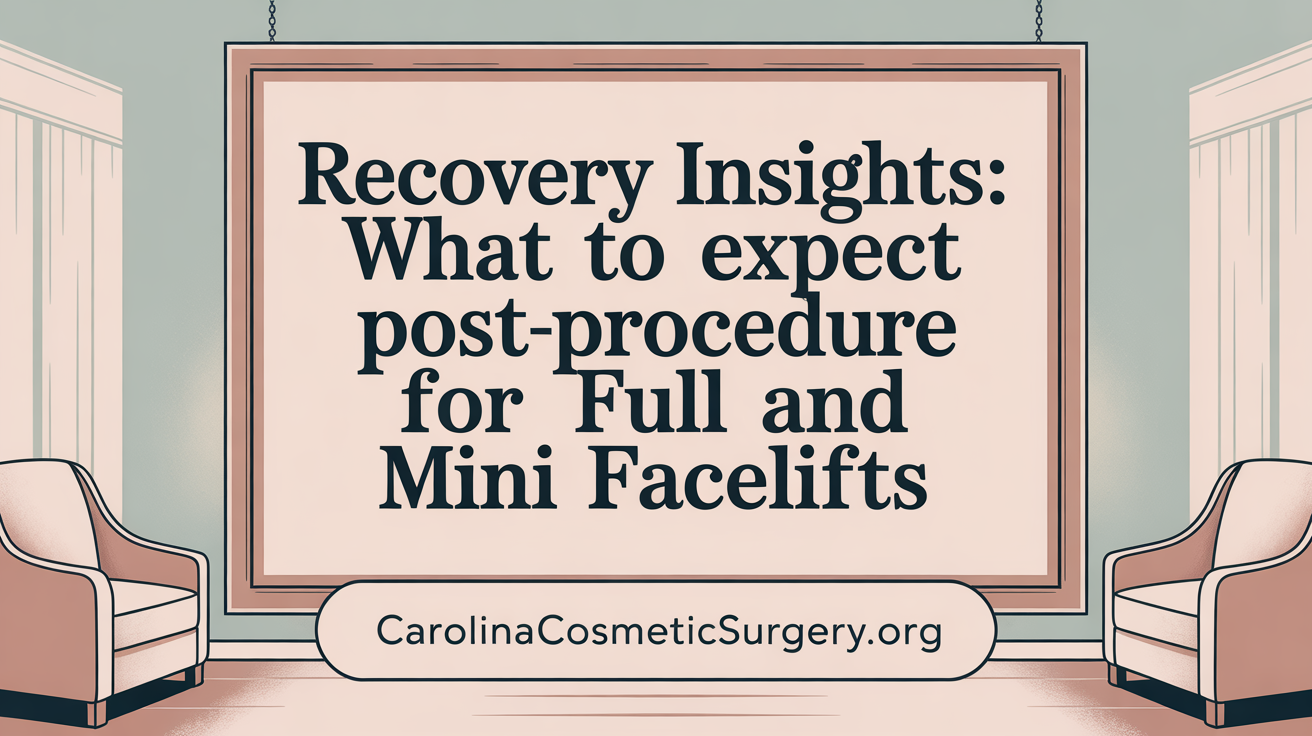Understanding Facelift Options
Facelifts are a popular cosmetic procedure designed to combat signs of aging by tightening skin and underlying muscles, enhancing facial contours. With advancements in facial plastic surgery, patients now have options ranging from less invasive mini facelifts to comprehensive full facelifts. This article explores the key differences, benefits, candidate suitability, procedural aspects, recovery expectations, risks, and costs to help you decide which facelift option might be best for your individual needs.
Key Differences Between Full Facelift and Mini Facelift
What are the main distinctions between a full facelift and a mini facelift?
The choice between these two procedures primarily depends on the extent of aging signs and the areas needing rejuvenation.
A full facelift is a comprehensive procedure that tackles advanced signs of aging across the entire face and neck. It involves longer incisions around the ears and scalp, removal of excess skin, and tightening of underlying muscles, especially the SMAS layer. This results in a more dramatic transformation, lifting sagging cheeks, jowls, and tightening the neck. The surgery usually lasts 3 to 5 hours under general anesthesia. Its effects can last 10-15 years, making it ideal for individuals with significant skin laxity and deep wrinkles.
In contrast, a mini facelift focuses on specific areas, particularly the lower face such as the jawline, jowls, and nasolabial folds. It involves shorter incisions, often hidden behind the ears, and less extensive tissue manipulation. Typically performed under local anesthesia with sedation, it lasts about 1 to 2 hours. The results are more subtle,-lasting approximately 3 to 5 years, illustrating its suitability for patients with early or moderate aging signs.
Extent of procedures
- Full Facelift: Extensive; addresses upper, mid, and lower face including the neck.
- Mini Facelift: Limited; mainly targets the jawline, jowls, and lower face.
Areas targeted
- Full Facelift: Cheeks, jawline, neck, and sometimes the upper face.
- Mini Facelift: Jawline, jowls, and mid-face.
Invasiveness and anesthesia
- Full Facelift: More invasive with longer incisions; performed under general anesthesia.
- Mini Facelift: Less invasive with smaller incisions; often uses local anesthesia with sedation.
Longevity of results
- Full Facelift: Results typically last 10 to 15 years.
- Mini Facelift: Results generally last 3 to 5 years.
Recovery duration
- Full Facelift: About 2 to 3 weeks; swelling and bruising may last several months.
- Mini Facelift: Usually 1 week; minor swelling and quicker return to daily activities.
Suitability based on age and signs of aging
- Full Facelift: Recommended for older individuals (usually over 60) with significant sagging, deep wrinkles, and skin laxity.
- Mini Facelift: Suitable for patients in their 30s to 50s with early signs of aging, mild to moderate sagging.
Choosing the right procedure depends on personal goals, health, and the specific aging changes in the face and neck. Consulting with a qualified facial plastic surgeon will help determine which approach best matches the patient's needs and expectations.
Benefits and Advantages of Full Facelift and Mini Facelift Procedures

What are the benefits and advantages of full facelift and mini facelift procedures?
A full facelift provides a comprehensive approach to facial rejuvenation, especially suitable for those with advanced signs of aging like deep wrinkles, sagging skin, and loss of muscle tone. This procedure involves longer incisions around the ears and hairline, allowing the surgeon to tighten and reposition the deeper facial tissues, including muscles. As a result, patients enjoy a more dramatic transformation that can last between 10 to 15 years. Although it requires a longer recovery period of about four to six weeks, the results are natural-looking and significant, effectively reversing the effects of aging.
In contrast, a mini facelift is designed for mild to moderate aging signs and younger patients, often in their 30s or 40s. It involves smaller incisions around the ears and targets only the lower face and jawline. This minimally invasive procedure is less intense, with shorter surgical duration and recovery time—typically around one week. The results of a mini facelift last around five to seven years, providing subtle yet noticeable improvements like tighter jowls and a more defined jawline.
Both procedures have their unique benefits. A full facelift offers the advantage of more long-lasting and comprehensive rejuvenation, ideal for those with significant facial aging. Meanwhile, a mini facelift provides a quicker recovery, less invasive approach, and more natural results for early or moderate aging signs. The best option depends on individual aging severity, aesthetic goals, and lifestyle considerations.
Ultimately, selecting the proper procedure should involve a detailed consultation with a qualified plastic surgeon, who can help tailor the approach to meet personal expectations and ensure optimal results.
Suitable Candidates and Their Aging Concerns

Who are the suitable candidates for full facelift and mini facelift procedures?
Choosing the right procedure depends on the severity of facial aging, individual health, and aesthetic goals. Typically, full facelift candidates are individuals experiencing pronounced signs of aging that affect the entire face and neck. These signs include deep wrinkles, significant sagging, jowls, and a loss of jawline definition. Most of these candidates are in their 40s to 70s. They should be in good overall health, have firm skin elasticity, and realistic expectations about long-lasting, dramatic results that can last between 7 to 15 years.
Mini facelift candidates are generally younger, often in their late 30s to early 50s, with early or mild to moderate sagging primarily in the lower face. They usually seek subtler improvements, such as softening nasolabial folds, tightening the jawline, and reducing mild jowling. Since the mini facelift is less invasive, candidates should have good skin elasticity and minimal skin laxity. It’s ideal for those who prefer a shorter recovery period, typically lasting 3 to 5 years, and are aiming for a more natural, youthful look.
Both groups should be in good health, non-smokers, and free of underlying medical conditions that could impair healing or increase surgical risks. Importantly, candidates should have clear, realistic goals and understand the extent of results each procedure can provide. For significant skin laxity and extensive aging signs, a full facelift remains the more effective option. Conversely, for early signs of aging or minor sagging, the mini facelift offers a suitable, less invasive alternative.
Ultimately, a comprehensive consultation with a board-certified plastic surgeon or facial specialist is essential. They can evaluate individual facial anatomy, skin quality, and aging patterns to recommend the best tailored approach.
More Info Search Query
Ideal candidates for full facelift versus mini facelift
Procedural Techniques and Differences

What are the procedural differences and techniques involved in full facelift versus mini facelift?
Full facelifts and mini facelifts differ mainly in the extent of surgery, incision placement, anesthesia, and tissue manipulation.
Full facelift procedures involve longer, more comprehensive incisions that generally extend around the ears, into the hairline, and sometimes under the chin. These longer incisions allow surgeons to access and tighten deeper tissues, such as the SMAS layer and platysma muscles, which are essential for more dramatic rejuvenation of the midface, jowls, and neck.
In contrast, mini facelifts use shorter incisions, typically placed around or slightly in front of the ears. These smaller incisions limit the surgeon's access to superficial tissues, focusing primarily on tightening the skin and superficial muscular layers in the lower face and jawline.
The type of anesthesia also varies: full facelifts are performed under general anesthesia due to their longer duration and complexity, while mini facelifts are often done under local anesthesia with sedation, reducing overall risk and recovery time.
Surgically, full facelifts require extensive tissue repositioning, including tightening and lifting of muscles and removal of excess skin, resulting in more noticeable and longer-lasting results. They take about 3 to 4 hours, and patients typically need about 10 to 14 days of recovery.
Mini facelifts involve less tissue dissection, shorter surgery time—usually around 1 to 1.5 hours—and a quicker recovery period of roughly 1 week. They target mild to moderate skin laxity primarily in the lower face, offering subtler but still natural improvements.
In summary, the choice between a full and mini facelift depends on the extent of aging, the areas needing correction, and patient preferences for recovery and invasiveness. Both techniques are effective but tailored to different facial aging levels and aesthetic goals.
Recovery, Risks, and Potential Complications

What is the typical recovery process and timeline for full facelift and mini facelift procedures?
Recovery from a full facelift typically spans about 10 to 14 days, allowing most patients to return to their usual routines within this period. Swelling and bruising are common during the first few weeks post-surgery, gradually diminishing over one to two months. It may take up to six months for the final results to fully settle and become visible. A full facelift involves more extensive incisions and tissue manipulation, leading to a longer healing process. Patients are generally advised to avoid strenuous activities for at least two weeks. In comparison, a mini facelift usually requires only about 3 to 5 days of downtime. Many patients feel comfortable resuming normal activities within a week. Swelling and bruising in mini procedures tend to resolve more quickly, with full recovery often achieved within 2 to 4 weeks. Overall, while the recovery timeline varies depending on the procedure, both techniques offer relatively swift recoveries considering the significant aesthetic improvements achieved.
Cost Considerations and Longevity of Results

How do the costs of a mini facelift compare to those of a full facelift?
Mini facelifts are generally less costly than full facelifts due to the less invasive nature of the procedures. These shorter surgeries, often performed under local anesthesia, involve smaller incisions and less tissue manipulation, which reduces surgical time and associated expenses.
Typical costs for mini facelifts range from around $4,100 to $18,500, with an average approximately $10,300. In contrast, full facelifts involve longer operating times, more extensive tissue repositioning, and often require general anesthesia, leading to higher costs. These can range from about $5,600 to $48,000, with an average near $17,400.
Factors influencing these costs include the surgeon’s experience, geographic location, facility fees, anesthesia expenses, and any additional procedures performed simultaneously. Patients should consult qualified surgeons to receive personalized estimates and ensure their choices align with their aesthetic goals and budget.
How long do the results of a mini facelift typically last?
The effects of a mini facelift generally last between five to ten years. Most patients experience a visible improvement in facial contours and skin tightness for about a decade. This shorter duration compared to a full facelift, which can last 10 to 20 years, stems from the less extensive tissue tightening involved.
Individual factors such as skin elasticity, lifestyle choices, genetics, and ongoing aging influence how long these results are maintained. While a mini facelift can significantly enhance appearance and provide a more youthful look, ongoing skin aging will continue naturally.
Overall, patients can enjoy long-lasting benefits, but regular skincare, sun protection, and healthy habits may help prolong the results. For sustained outcomes, some choose to undergo supplementary treatments or periodic touch-ups.
| Procedure Type | Typical Cost Range | Result Duration | Main Factors Affecting Longevity |
|---|---|---|---|
| Mini Facelift | $4,100 - $18,500 | 5-10 years | Skin type, aging pace, lifestyle, genetics |
| Full Facelift | $5,600 - $48,000 | 10-20 years | Skin quality, extent of aging, surgical technique |
Choosing the right procedure involves balancing desired longevity with recovery time and invasiveness. Consulting with a skilled facial plastic surgeon can help determine the best option based on individual goals.
Choosing the Right Facelift for You
Deciding between a full facelift and a mini facelift ultimately depends on your unique aging concerns, health status, aesthetic goals, and tolerance for recovery time. Full facelifts offer the most comprehensive and long-lasting rejuvenation for advanced aging but come with longer downtime and higher costs. Mini facelifts provide a less invasive option for younger patients with mild to moderate signs of aging, featuring quicker recovery and subtler yet effective results. Consulting with a board-certified facial plastic surgeon is essential to evaluate your facial anatomy and help tailor a procedure that best aligns with your expectations and lifestyle.
References
- Full or Mini Facelift: Which is Right for Me? | University of Utah Health
- Full Facelift vs Mini Facelift - Anthony MacQuillan Plastic Surgeon
- Mini Face Lift vs. Full Face Lift: Which One Is Right For You?
- Full Facelift vs. Mini Face Lift: What's the Difference?
- Mini Facelift vs Traditional Facelift: Which Is Right for You?
- Mini Facelift Vs. Facelift: Which is Better? - Dr. Karolak
- Mini vs Full Facelift Surgery: What Is the Difference? | Dr. Mussat
- Mini Facelift vs. Full Facelift: Recovery, Results, and Costs Compared
